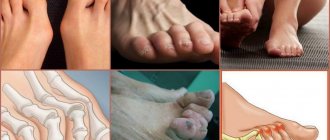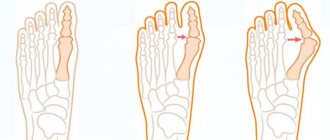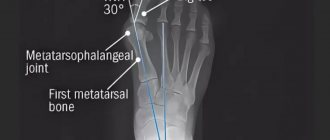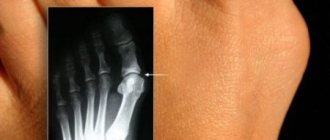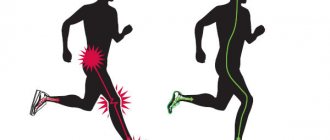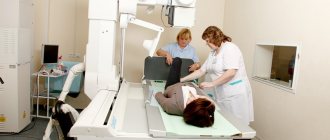- Surgical department
Surgical department » - Traumatology and orthopedics
Traumatology and orthopedics »
- About the direction
About the direction »
- Treatment of bunions: Hallux valgus
An operation to remove a bunion is performed when there is a hallux valgus deformity that provokes a change in the location of the phalanges. Foot deformation does not look aesthetically pleasing, interferes with the selection of shoes and complicates a person’s life, causing pain, discomfort, as well as some physical limitations. Surgery is not always required, but in some cases it cannot be avoided.
In our clinic in St. Petersburg, treatment is carried out using various techniques, including removal of bunions. The operation is performed by a candidate of medical sciences with more than 30 years of practice, a well-known traumatologist in the city, Viktor Mikhailovich Bykov. The cost of surgery to remove a bone depends on many factors, including the individual characteristics of the patient.
Causes and symptoms
A bunion on the thumb occurs for various reasons - provoking factors can be:
- excess weight;
- tight, uncomfortable or poor quality shoes;
- flat feet;
- genetic predisposition;
- professional activity when a person is forced to stand on his feet for a long time;
- damage to nervous tissue;
- gout and some other diseases affecting the condition of the joints;
- diabetes.
It is not difficult to recognize the occurrence of hallux valgus, especially if visible signs have already appeared. Contact our clinic for conservative therapy and surgical removal of a bunion in St. Petersburg if symptoms appear:
- swelling, expansion of the base of the finger;
- the presence of a skin growth or callus on the side, in the area where the toe meets the base of the foot;
- the thumb changed its angle and became more turned towards the other fingers;
- pain appears when wearing tight shoes or even when walking normally;
- inflammation and associated symptoms occur;
- night cramps;
- stiffness in leg movements due to pain.
In difficult cases, not only the big toe is deformed, but also those next to it. And calluses form on the feet.
Reasons for the appearance of stars on legs
The main cause of spider veins on the legs is hormonal imbalance, including those caused by taking oral contraceptives. This explains why telangiectasia affects more women than men. Other reasons include the following:
- genetic predisposition
- pregnancy
- chronic skin diseases, including rosacea
- overweight
- increased load on the legs
- excessive exposure to solar radiation
- hypertension
- endocrine pathologies
- chronic venous insufficiency
- bad habits (in particular, smoking) and others.
Degrees of hallux valgus
There are four stages of the disease, each of which has its own symptoms:
First degree. The changes are practically unnoticeable, there is no pain or discomfort. The inclination does not exceed 15 degrees.
Second degree. Deviation from the norm – up to 20 degrees. A person begins to experience the first symptoms of the disease - aching pain and discomfort. Moreover, their intensity increases in the evening, when wearing uncomfortable or unsuitable shoes, after a long stay on your feet.
Third degree. The deflection angle is already 20–30 degrees. Pain and discomfort, difficult to choose shoes. Night cramps and symptoms of the inflammatory process appear.
Fourth degree. The critical stage at which the angle of inclination exceeds 30 degrees. The thumb and the fingers next to it are subject to deformation. It is difficult for a person to lead a normal lifestyle, move around, and the foot becomes twisted. Treatment is possible only through surgery.
Spider veins appeared on the legs
Spider veins, or telangiectasia, are a persistent dilatation of small vessels of a non-inflammatory nature.
Not only small veins can be affected, but also arteries and capillaries. They differ in color: dilated arterioles and capillaries are red and do not stand out above the surface of the skin. Dilated veins have a bluish tint and may protrude slightly. The stars are usually localized on the inner and back of the thighs, calves and ankles (but can also be on other parts of the body, in particular on the face). Over the age of 75, about 70% of the population suffers from this disease, however, among young people under 45, about a third note the appearance of a fine network of blood vessels on the legs.
The diameter of the dilated vessels does not exceed 1 mm. The configuration of the “stars” can be very different - actually star-shaped, tree-shaped, or in the form of several parallel thin lines or spots. All these formations, regardless of form, are of a similar nature.
Spider veins do not cause discomfort: they do not cause pain or other unpleasant sensations. This explains why patients go to the doctor only when small vessels on the legs become an “aesthetic” problem: for example, before the summer season. Meanwhile, a visit to a phlebologist should not be postponed if spider veins appear on the legs.
Diagnosis and treatment
When a bone appears, treatment should begin as soon as possible. If in the first stages it is possible to completely get rid of the problem using non-invasive conservative methods, then as the disease progresses, surgical intervention is increasingly required.
Conservative treatment
At the first stage of the disease, conservative treatment methods are effective:
- the use of special orthopedic products that minimize pressure and load on the bone - insoles, clamps, special pads and fabric bandages;
- changing shoes to more comfortable and high-quality ones;
- normalization of weight and elimination of the negative influence of other factors that provoke hallux valgus;
- massage and other treatments.
Surgery
If conservative methods do not give the desired effect, surgery to remove the bunion is necessary. You can have it done in St. Petersburg, as well as undergo all the necessary examinations and undergo rehabilitation after surgery in our clinic.
At RAMI, removal of bunions is carried out under general anesthesia. The method and duration of anesthesia are selected individually. The operation is performed in an operating room equipped with the latest technology, by highly qualified doctors with extensive experience.
Types of operations for hallux valgus
Operations to remove bunions are carried out using different methods, which can be divided into two groups:
1. performing classical open surgery;
2. use of minimally invasive techniques.
In our clinic in St. Petersburg, surgery to remove bunions is performed using different techniques. Most often, specialists try to improve the patient’s condition using minimally invasive methods, since they are less traumatic and rehabilitation is faster. In other cases, open surgery is used.
Both minimally invasive and open operations are carried out in several stages:
1. Preparing for the procedure, which may take a week or more. At this time, all necessary tests are collected, examinations and consultations with specialists are carried out. Your doctor will tell you more about preparing for surgery at your appointment.
2. The operation itself.
3. Rehabilitation after bone removal. This includes examinations by doctors, dressings, drug therapy, and wearing special braces. Also during the rehabilitation period, it is important to follow the recommendations of doctors and undergo prescribed physical procedures.
Open reconstructive interventions
Open operations are carried out in several stages:
1. Making an incision on the inside of the thumb.
2. Dissection of the joint capsule and its mobilization.
3. Removal of the callus itself.
4. Sawing of the metatarsal bone. It is carried out in several ways.
5. Moving bone fragments with changing the axis of the diseased thumb and fixing them with titanium screws.
6. The incision is sutured, and a sterile bandage is applied to the skin, which is additionally secured with a bandage over the entire leg.
The duration of the operation depends on the degree of complexity of the disease and varies between 30–120 minutes. The cost of surgery to remove a bunion in our clinic in St. Petersburg depends on the individual characteristics of the patient and the stage of the disease, and is therefore discussed individually.
Minimally invasive surgeries
Minimally invasive surgeries are popular because they have a minimum of contraindications, the occurrence of complications is practically excluded, and recovery is faster. They are carried out using special equipment through small holes in the patient's body. The surgeon resaws the bone and restores the correct shape of the finger. As a rule, such operations are recommended for the first and second degrees of the disease. Depending on the characteristics of the foot deformities, the following operations to remove bunions may be performed:
- exostectomy – the head of the metatarsal bone is removed;
- resection arthroplasty – excision of an element of a joint or end joint of a finger;
- correction of the transverse arch of the foot - the doctor changes the angle between the toe and the foot;
- laser removal of a bunion on the legs, the cost of which is higher, but the result obtained is worth it - the procedure is bloodless, is carried out the fastest, and has a minimum of possible complications;
- arthrodesis – ensures immobility of the joint of the first finger;
- osteotomy - excision of the phalanx of a finger or part of a bone;
- endoprosthetics – a deformed joint is replaced with an implant.
Why are varicose veins dangerous?
To this question, most of us will probably answer that spider veins are purely an aesthetic problem. Indeed, you no longer want to wear a short skirt or shorts with veined stars. However, this is not the main thing.
A network of small vessels that appears on the skin may indicate that you are developing varicose veins. In particular, you may already have dilated reticular veins - superficial vessels that have a diameter of about 2 mm and feed the spider vein. In addition, a fine network of red or blue vessels may indicate the presence of chronic venous insufficiency - a set of symptoms that indicates poor circulation in the veins.
Advantages of the RAMI clinic in the treatment of Hallux Valgus
The success of treatment depends on the experience of the surgeon and high-quality equipment in the operating room. For patients of the RAMI clinic, the most favorable conditions have been created for the effective treatment of hallux valgus:
- a modern operating unit that meets all medical standards;
- expert class surgical and anesthesia equipment;
- operation support with C-arm X-ray system;
- laboratory within the walls of the clinic, which allows you to obtain research results during the day;
- nine rooms in which the most comfortable conditions for patients’ stay are created - multifunctional beds, a health monitor, disposable clothing, high-quality food, digital TV and Wi-Fi;
- individual rehabilitation;
- personal manager for surgical treatment;
- your own pharmacy, with the ability to place orders for medications;
- service approach to working with patients.
Consultation with an orthopedic traumatologist is the first step to getting rid of the problem. Sign up by phone: +7 (812) 627-13-13.
If you are really looking for your doctor...
Treatment of spider veins on the legs
Spider veins require complex treatment: in most cases it takes place in two stages. The varicose veins feeding the sprocket should be removed first. This is done by sclerotherapy: during the procedure, a special drug, a sclerosant, is injected into the lumen of the vein, which “glues” it together. Thus, it is excluded from the bloodstream, its functions are taken over by other veins. Gradually the sclerotic vessel resolves.
After this, it’s time to remove the asterisk itself, for which doctors at the Phlebology Center use a neodymium laser. Its advantages are the ability to individually select the laser wavelength, as well as the precise, targeted effect of the laser beam on the vessel. The laser has the same effect on the veins as a sclerosant - it glues them together. As a result, small vessels disappear completely, and larger vascular formations, such as hemangiomas, become less noticeable.
For complete or almost complete removal of spider veins, a course of treatment of 2-4 procedures is required.
To make the treatment more effective, as well as to prevent relapses, patients should wear the recommended compression stockings after the procedure, which ensures correct pressure on the veins.
